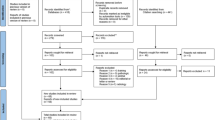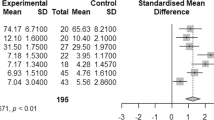Abstract
Introduction
Three-dimensional (3D)-printed models have become increasingly popular as an alternative to the traditional method of cadaveric dissection in teaching anatomy. It has the advantage of lower cost and higher reproducibility. It has been widely used in the postgraduate setting, but its efficacy in undergraduate education has not been studied extensively.
Objectives
A scoping review of the literature was undertaken systematically to investigate the role of 3D printing in the anatomy education of undergraduate medical students.
Methods
A systematic literature search of databases (EMBASE, Pubmed, Educational Resources Information Center, British Education Index and Australian Education Index) was undertaken using relevant keywords.
Results
The search yielded 83 results, which were narrowed down to 13 articles after application of exclusion criteria. The literature supported that 3D printing was a useful tool for studying normal, uncommon and pathological anatomy. However, limitations include low fidelity in replicating the colour and textural physical properties of soft tissues and the trade-off between cost and fidelity.
Conclusions
It is believed that 3D printing would increasingly be integrated into undergraduate anatomy education, and it might also potentially be used in the assessment of anatomical knowledge and clinical skills training. The establishment of an online 3D model database may facilitate educators to easily manufacture models for specific educational purposes.

Similar content being viewed by others
References
McLachlan JC, Patten D. Anatomy teaching: ghosts of the past, present and future. Med Educ. 2006;40(3):243–53. https://doi.org/10.1111/j.1365-2929.2006.02401.x.
Balestrini C, Campo-Celaya T. With the advent of domestic 3-dimensional (3D) printers and their associated reduced cost, is it now time for every medical school to have their own 3D printer? Med Teach. 2016;38(3):312–3. https://doi.org/10.3109/0142159X.2015.1060305.
Reznick RK, MacRae H. Teaching surgical skills--changes in the wind. N Engl J Med. 2006;355(25):2664–9. https://doi.org/10.1056/NEJMra054785.
Li C, Cheung TF, Fan VC, Sin KM, Wong CW, Leung GK. Applications of three-dimensional printing in surgery. Surg Innov. 2017;24(1):82–8. https://doi.org/10.1177/1553350616681889.
Chen S, Pan Z, Wu Y, Gu Z, Li M, Liang Z, et al. The role of three-dimensional printed models of skull in anatomy education: a randomized controlled trail. Sci Rep. 2017;7(1):575. https://doi.org/10.1038/s41598-017-00647-1.
Wu AM, Wang K, Wang JS, Chen CH, Yang XD, Ni WF, et al. The addition of 3D printed models to enhance the teaching and learning of bone spatial anatomy and fractures for undergraduate students: a randomized controlled study. Ann Transl Med. 2018;6(20):Y. https://doi.org/10.21037/atm.2018.09.59.
McLachlan JC, Bligh J, Bradley P, Searle J. Teaching anatomy without cadavers. Med Educ. 2004;38(4):418–24. https://doi.org/10.1046/j.1365-2923.2004.01795.x.
Sugand K, Abrahams P, Khurana A. The anatomy of anatomy: a review for its modernization. Anat Sci Educ. 2010;3(2):83–93. https://doi.org/10.1002/ase.139.
Nicholson DT, Chalk C, Funnell WR, Daniel SJ. Can virtual reality improve anatomy education? A randomised controlled study of a computer-generated three-dimensional anatomical ear model. Med Educ. 2006;40(11):1081–7. https://doi.org/10.1111/j.1365-2929.2006.02611.x.
Levinson AJ, Weaver B, Garside S, McGinn H, Norman GR. Virtual reality and brain anatomy: a randomised trial of e-learning instructional designs. Med Educ. 2007;41(5):495–501. https://doi.org/10.1111/j.1365-2929.2006.02694.x.
Khot Z, Quinlan K, Norman GR, Wainman B. The relative effectiveness of computer-based and traditional resources for education in anatomy. Anat Sci Educ. 2013;6(4):211–5. https://doi.org/10.1002/ase.1355.
Brice J, Corrigan O. The changing landscape of medical education in the UK. Med Teach. 2010;32(9):727–32. https://doi.org/10.3109/0142159X.2010.497828.
Schubert C, van Langeveld MC, Donoso LA. Innovations in 3D printing: a 3D overview from optics to organs. Br J Ophthalmol. 2014;98(2):159–61. https://doi.org/10.1136/bjophthalmol-2013-304446.
Michalski MH, Ross JS. The shape of things to come: 3D printing in medicine. JAMA. 2014;312(21):2213–4. https://doi.org/10.1001/jama.2014.9542.
PRISMA. PRISMA checklist. 2009. http://www.prisma-statement.org/documents/PRISMA%202009%20checklist.doc. Accessed 6/1/2019.
Elsevier. Embase(R). Elsevier. 2018. https://www.elsevier.com/solutions/embase-biomedical-research. Accessed 25/11/2018.
National Center for Biotechnology Information. PubMed. 2018. https://www.ncbi.nlm.nih.gov/pubmed/. Accessed 25/11/2018.
U.S. Department of Education. ERIC. 2018. https://eric.ed.gov. Accessed 25/11/2018.
EBSCO. British Education Index. 2018. https://www.ebsco.com/products/research-databases/british-education-index. Accessed 25/11/2018.
Cunningham Library. Australian Education Index. 2018. https://www.acer.org/library/australian-education-index-aei. Accessed 25/11/2018.
Smith CF, Tollemache N, Covill D, Johnston M. Take away body parts! An investigation into the use of 3D-printed anatomical models in undergraduate anatomy education. Anat Sci Educ. 2018;11(1):44–53.
Garas M, Vaccarezza M, Newland G, McVay-Doornbusch K, Hasani J. 3D-Printed specimens as a valuable tool in anatomy education: a pilot study. Ann Anat. 2018;219:57–64. https://doi.org/10.1016/j.aanat.2018.05.006.
Lim KHA, Loo ZY, Goldie SJ, Adams JW, McMenamin PG. Use of 3D printed models in medical education: a randomized control trial comparing 3D prints versus cadaveric materials for learning external cardiac anatomy. Anat Sci Educ. 2016;9(3):213–21.
Mogali SR, Yeong WY, Tan HKJ, Tan GJS, Abrahams PH, Zary N, et al. Evaluation by medical students of the educational value of multi-material and multi-colored three-dimensional printed models of the upper limb for anatomical education. Anat Sci Educ. 2018;11(1):54–64. https://doi.org/10.1002/ase.1703.
Fasel JH, Aguiar D, Kiss-Bodolay D, Montet X, Kalangos A, Stimec BV, et al. Adapting anatomy teaching to surgical trends: a combination of classical dissection, medical imaging, and 3D-printing technologies. Surg Radiol Anat SRA. 2016;38(3):361–7. https://doi.org/10.1007/s00276-015-1588-3.
O'Reilly MK, Reese S, Herlihy T, Geoghegan T, Cantwell CP, Feeney RNM, et al. Fabrication and assessment of 3D printed anatomical models of the lower limb for anatomical teaching and femoral vessel access training in medicine. Anat Sci Educ. 2016;9(1):71–9.
Young JC, Quayle MR, Adams JW, Bertram JF, McMenamin PG. Three-dimensional printing of archived human fetal material for teaching purposes. Anat Sci Educ. 2018;12:90–6. https://doi.org/10.1002/ase.1805.
AlAli AB, Griffin MF, Calonge WM, Butler PE. Evaluating the use of cleft lip and palate 3D-printed models as a teaching aid. J Surg Educ. 2017. https://doi.org/10.1016/j.jsurg.2017.07.023.
Lee H, Nguyen NH, Hwang SI, Lee HJ, Hong SK, Byun SS. Personalized 3D kidney model produced by rapid prototyping method and its usefulness in clinical applications. Int Braz J Urol. 2018;44(5):952–7. https://doi.org/10.1590/S1677-5538.IBJU.2018.0162.
Guillot A, Champely S, Batier C, Thiriet P, Collet C. Relationship between spatial abilities, mental rotation and functional anatomy learning. Adv Health Sci Educ. 2007;12:491–507.
Johnson EO, Charchanti AV, Troupis TG. Modernization of an anatomy class: from conceptualization to implementation. A case for integrated multimodal-multidisciplinary teaching. Anat Sci Educ. 2012;5(6):354–66. https://doi.org/10.1002/ase.1296.
Luursema J-MV, Willem B, Kommers PAM, Annema J-H. The role of stereopsis in virtual anatomical learning. Interact Comput. 2008;20(4-5):455–60.
Brewer DN, Wilson TD, Eagleson R, de Ribaupierre S. Evaluation of neuroanatomical training using a 3D visual reality model. Stud Health Technol Inform. 2012;173:85–91.
Govsa F, Ozer MA, Sirinturk S, Eraslan C, Alagoz AK. Creating vascular models by postprocessing computed tomography angiography images: a guide for anatomical education. Surg Radiol Anat SRA. 2017;39(8):905–10. https://doi.org/10.1007/s00276-017-1822-2.
Marton FS, R. On qualitative differences in learning: I. Outcome and process. Br J Educ Psychol. 1976;46(1):4–11.
Jones DB, Sung R, Weinberg C, Korelitz T, Andrews R. Three-dimensional modeling may improve surgical education and clinical practice. Surg Innov. 2016;23(2):189–95. https://doi.org/10.1177/1553350615607641.
Wilson KK, James H. Attention during lectures: beyond ten minutes. Teach Psychol. 2007;34(2):85–9.
Wood D, Bruner JS, Ross G. The role of tutoring in problem solving. J Child Psychol Psychiatry. 1976;17(2):89–100.
Harden RM. What is a spiral curriculum? Med Teach. 1999;21(2):141–3. https://doi.org/10.1080/01421599979752.
Greening T. Scaffolding for success in problem-based learning. Med Educ Online. 1998;3(1):4297.
Vasan NS, DeFouw D. Team learning in a medical gross anatomy course. Med Educ. 2005;39(5):524. https://doi.org/10.1111/j.1365-2929.2005.02146.x.
Biggs J Aligning teaching for constructing learning. The Higher Education Academy. 2003. https://www.heacademy.ac.uk/system/files/resources/id477_aligning_teaching_for_constructing_learning.pdf.
Balta JY, Cronin M, Cryan JF, O'Mahony SM. The utility of cadaver-based approaches for the teaching of human anatomy: a survey of British and Irish anatomy teachers. Anat Sci Educ. 2017;10(2):137–43. https://doi.org/10.1002/ase.1629.
Amazon. Amazon.co.uk. 2018. http://www.amazon.co.uk. Accessed 25/11/2018.
Maran NJ, Glavin RJ. Low- to high-fidelity simulation - a continuum of medical education? Med Educ. 2003;37(Suppl 1):22–8.
Matsumoto ED, Hamstra SJ, Radomski SB, Cusimano MD. The effect of bench model fidelity on endourological skills: a randomized controlled study. J Urol. 2002;167(3):1243–7.
McGaghie WC, Issenberg SB, Petrusa ER, Scalese RJ. A critical review of simulation-based medical education research: 2003-2009. Med Educ. 2010;44(1):50–63. https://doi.org/10.1111/j.1365-2923.2009.03547.x.
Munshi FL. Hani; Alyousef, Sawsan. Low- versus high-fidelity simulations in teaching and assessing clinical skills. J Taibah Univ Med Sci. 2015;10(1):12–5.
Backhouse S, Taylor D, Armitage JA. Is this mine to keep? Three-dimensional printing enables active, personalized learning in anatomy. Anat Sci Educ. 2018;12:518–28. https://doi.org/10.1002/ase.1840.
John LK, Loewenstein G, Prelec D. Measuring the prevalence of questionable research practices with incentives for truth telling. Psychol Sci. 2012;23(5):524–32. https://doi.org/10.1177/0956797611430953.
Bekkers R Risk factors for fraud and academic misconduct in the social sciences. 2012. https://renebekkers.wordpress.com/2012/11/29/risk-factors-for-fraud-and-academic-misconduct-in-the-social-sciences/. Accessed 25/11/2018.
Kneebone R. Simulation in surgical training: educational issues and practical implications. Med Educ. 2003;37(3):267–77.
Issenberg SB, McGaghie WC, Petrusa ER, Lee Gordon D, Scalese RJ. Features and uses of high-fidelity medical simulations that lead to effective learning: a BEME systematic review. Med Teach. 2005;27(1):10–28. https://doi.org/10.1080/01421590500046924.
Smith ML, Jones JFX. Dual-Extrusion 3D Printing of anatomical models for education. Anat Sci Educ. 2018;11(1):65–72.
McMenamin PG, Quayle MR, McHenry CR, Adams JW. The production of anatomical teaching resources using three-dimensional (3D) printing technology. Anat Sci Educ. 2014;7(6):479–86. https://doi.org/10.1002/ase.1475.
Brown S. Assessment for learning. Learn Teach High Educ. 2004;1:81–9.
Acknowledgements
The author would like to acknowledge the contribution of Dr. Lucy Spowart, PFHEA, FAcadMEd (University of Plymouth) for proofreading the manuscript and contributing to some of the discussion points mentioned.
Author information
Authors and Affiliations
Corresponding author
Ethics declarations
Conflict of Interest
The author declares that he has no conflict of interest.
Ethical Approval
NA
Informed Consent
NA
Additional information
Notes on Contributors
Jason Yuen, M.Sci., M.A. (Cantab), B.M. B.Ch. (Oxon), M.R.C.S., P.G.Cert. Clin. Ed. is an honorary University Fellow (teaching) at Plymouth University Peninsula Schools of Medicine & Dentistry, England. He is also a Neurosurgical Registrar at Derriford Hospital, Plymouth. He regularly teaches and assesses undergraduate students (formally and informally) and has a strong interest in surgical education.
Publisher’s Note
Springer Nature remains neutral with regard to jurisdictional claims in published maps and institutional affiliations.
Rights and permissions
About this article
Cite this article
Yuen, J. What Is the Role of 3D Printing in Undergraduate Anatomy Education? A Scoping Review of Current Literature and Recommendations. Med.Sci.Educ. 30, 1321–1329 (2020). https://doi.org/10.1007/s40670-020-00990-5
Published:
Issue Date:
DOI: https://doi.org/10.1007/s40670-020-00990-5




